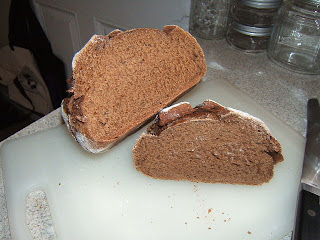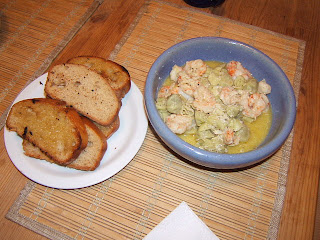I'm a Southern gal, but that doesn't mean that I am not willing to learn how things are done elsewhere. Sometimes you learn a thing or two about a thing or two. And now the Japanese are teaching me about making bread.
Yes, you heard me. But this is different.
This is making bread from wild yeast fruit water.
Southerners are nothing if not wild and, er, fruity. And honestly, with all the beer ingested per capita below the Mason-Dixon line, we're pretty yeasty, too. So maybe this ain't so much of a stretch.
It started like this:

Those are grapes from my local farmers' market in water with a little bit of Trader Joe's Organic Agave Sweetener in it. I didn't much like the sweetener for general use, so I decided to use it in the making of my yeast water. I also added some tangerine peel from the tree out back. It had just rained, so most of the pollution had presumably been washed away. (and yes, that's a used Tequila bottle. Mexico can't be bad. It makes tequila. Besides, they're more Southerly than us, which makes them Southern. 'nuff said.)
The idea is that yeast grows on all living plants, so you want to capture them. Yeast exists naturally on all fruits and grains. Yeasts on grapes do the heavy lifting to make wine. The yeast on apples makes cider. Commercial yeast is really yeast from grains that proved itself amenable to cultivation and shipping. Like most commercial endeavors, the point is to sell stuff, so the selling point of commercial yeast is reliability. It reliably raises bread. It also reliably tastes somewhat like cardboard, but you can get it everywhere, and it raises the bread. It also raises bread FAST, and we humans like it fast nowadays.
There's something like 100,000 times more yeast cells in a gram of commercial yeast than in a gram of this yeast water, but given time, this yeast water will do the same thing commercial yeast does - raise bread. The main difference is that THIS bread will have good flavor. You just have to wait a minute for it to work.
Commercial yeast and chemical leaveners are relatively new. Humans have been baking leavened bread for thousands of years, and this is one of the methods. The other popular ancient method is levain (pronounced Luh-VAN. That's French, see.), which is flour and water allowed to ferment. The yeast that was on the grains got mixed into the flour as it was ground, so the yeast is still there. The yeast grows and the mix is thrown in with other flour and water to make bread. The Egyptians did it this way, too.
So, this is the Japanese method. You can use fresh fruits, dried (unsulphured) fruits, veggies, grains, or even tea leaves. That's right, tea leaves. You can imagine my delight at the thought of raising bread with sweet tea. :D
So, after a couple days, my fruity water looked like this:

Note the traditional levain next to it. I killed that one. :( Beware leaving your yeast starters on top of the stove. They're like to die when you heat up your oven.
So, I used the yeast water along with a little
King Arthur White Whole Wheat flour and
King Arthur All Purpose (NOT an endorsement! This was cheapish, middling quality, and readily available at Trader Joe's. It is neither organic nor stone-ground. BAD! It is unbleached and unbromated, which is good. An organic version is available on their website.) flour, a little
Penzey's French Grey Sea Salt (YES! this is an endorsement! Buy EVERYTHING this company has to offer! Download their catalog and drool!), and got this:

Danged if it weren't tasty!
Here's the recipe I used. You'll need to proceed to the next post to get the full recipe

Since I'm a perfectionist Southern cook, I am allowed to chide myself for not achieving a higher rise, more open crumb, or better slashing. I'm also allowed to wail about the burnt bottom crust. I also put that in so you don't feel so bad if you mess it up, too. To be fair, this was attempt #3. Y'all will laugh when you see pictures of the next one!
So, I've made some more, and I'll post photos from those soon. Meanwhile, do head over to
Wao's Blog. It's called
Bread and Original Yeast. It's her fine writing that made me join this mania. I've searched quite a bit and not seen any site in English that explains this method other than hers. If you want to know how to begin, just head back to the beginning of this blog to the February 2008 posts. Be sure to comment and let her know why you dropped by. She's real sweet about answering questions.
She also posted info on the wonderful site called
The Fresh Loaf. I love their forum. I found most other baking information that I needed, such as dough slashing methods, how to knead, and what the heck is a couche on there. Nice folks.
I'll work on my levain, and I'll keep working on my bread. Meanwhile, stay tuned. I hear tell of a friend who needs help leaning how to cook, and I reckon I'll oblige.
Y'all have a nice day, now.














